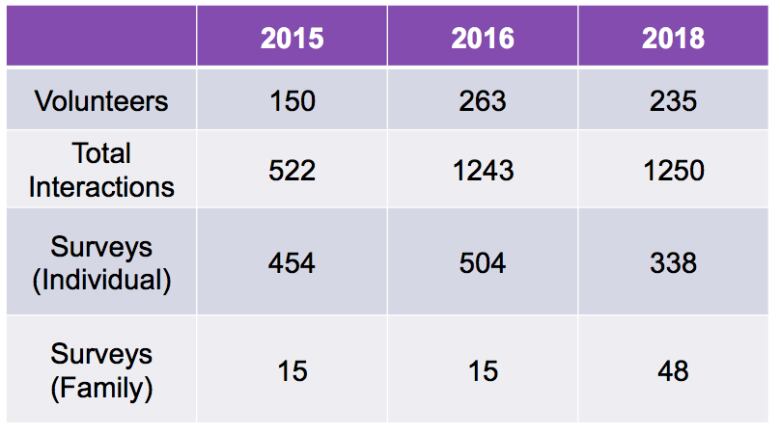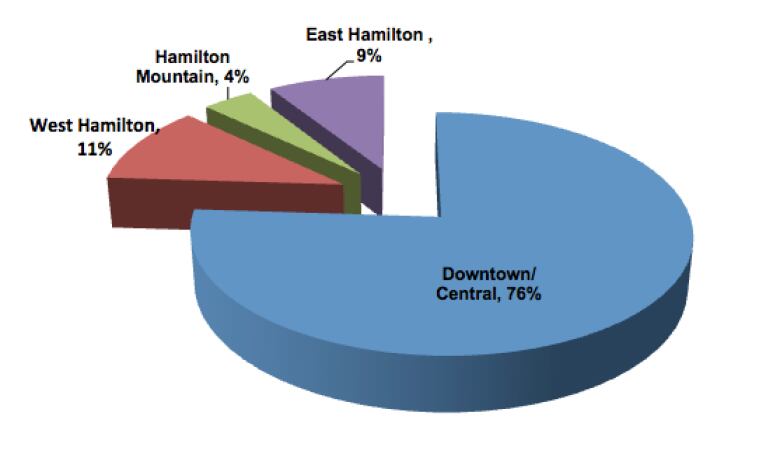Survey shows progress in Hamilton's fight against homelessness
The survey found 25 per cent fewer homeless people in the city

A survey of homelessness in Hamilton suggests there is a significant drop in the number of Hamiltonians with nowhere to live.
The city and its numerous partners did a Point in Time Connection survey this year of people who identified as homeless and it showed a 25 per cent reduction.
It's a strong indication that local efforts to get people off the streets are making progress.
We're trending in the right direction.- AmandaDiFalco,manager of homelessness policy & programs
The team had roughly same number of volunteers, and used the same methods as 2016, saysAmanda DiFalco, the city's manager of homelessness policy & programs.
The result: 338 people and 48 families filled out the survey, compared to504 individuals and 15 families two years earlier.
It's not an exact picture, DiFalco said Friday. The number of homeless fluctuates according to weather and time of year. Relying on one snapshot is like gauging the weather using one day's forecast. But she's optimistic.


"This is a good thing for this community," she said. "It's not easy work, but progress is being made. We're trending in the right direction."
"Homelessness is in fact a solvable problem. I know this because I can see it in the results."
Hamilton has put significant effort into reducing homelessness in the last three years.
In 2015, it was the third Canadian city to jointhe 20,000 Homes campaign aimed at housing the chronically homeless. (That term describes people who have been homeless for six months or longer.) The campaign focused on individuals and providing what they needed to find and keep housing.


The provincial and federal governments have devoted more money to ending homelessness. So has the city, including pledging $50 million last year on housing for low-income residents.
Hamilton agencies have also made a more concerted effort to get co-ordinated, DiFalco said.
Pleased to be part of the Point in Time Count and involved with the reduction of chronically homeless - we've housed 150 chronically homeless last year with 95% housing retention rate plus supported 1,008 adults at Wesley Day Centre #HamOnt https://t.co/F6v11zt7Jk
—@wesleyurbanHere are some other numbers from the count:
- As in 2015 and 2016, men outnumbered women among those who were homeless. Men accounted for 66 per cent, women 32 per cent, and twoper cent identified as transgender or two spirit.
- While fewer individuals identified as homeless, there was a greater number of families who did. Families represented 12 per cent of respondents. Of those, 58 per cent cameto Canada as immigrants, refugees or refugee claimants. Half were lone parent households, and 83 per cent of those lone parent households were led by women.
- 39 per cent of respondents were aged 31 to 49. Thirty-eight had been homeless more than five years.
- 196 people surveyed, or 67 per cent, were chronically homeless, meaning they were homeless for six months or longer. Of those, 100 had severe issues or conditions that impacted their housing stability.
- 45 per cent of those surveyed had a chronic health condition, which is more than twice the national average.
- 86 respondents, or 22 per cent, had Indigenous ancestry. Of those,42 per cent been in foster care or a group home and87 per cent were on social assistance.
- Youth aged 16 to 24 accounted for 13 per cent of respondents. Of those,22 per cent were LGBTQ, 53 per cent were racial minorities and 33 per cent had been part of child welfare system.
- Among those surveyed, 44 per cent reported having a mental health condition,46 per cent hada chronic/acute medical condition and 43 per cent said they had addition issues.
- 21 per cent of those surveyed had been in jail or prison in the last sixmonths.
- 22 per centreported that they had been in foster care and/or a group home.
The Point in Time Connection is part of a national campaign led by the Canadian Alliance to End Homelessness.
In Hamilton, 235 volunteers and social service staff canvassed people, including representatives from more than 25 agencies.That includes several Indigenous agencies.












_(720p).jpg)


 OFFICIAL HD MUSIC VIDEO.jpg)
.jpg)



























































































